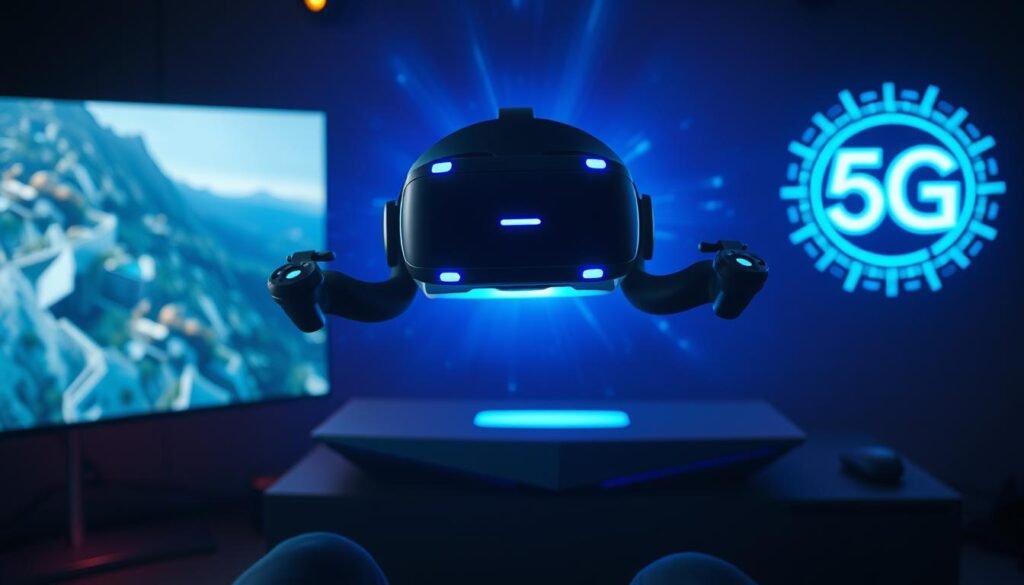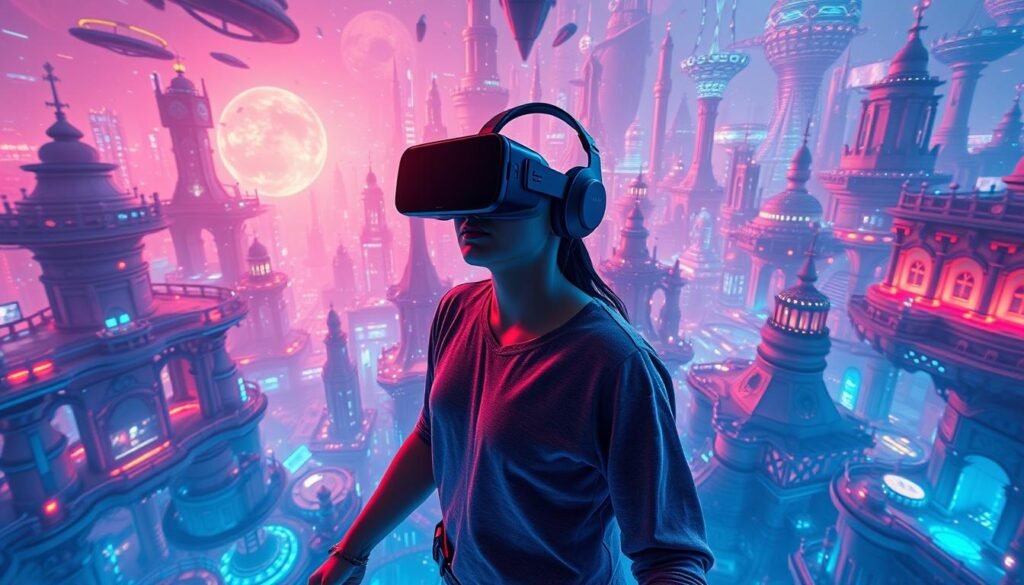Imagine being in the middle of an intense multiplayer game, where every millisecond counts. Suddenly, your screen freezes, and you lose the match. Frustrating, isn’t it? This scenario is becoming a thing of the past, thanks to the latest advancements in network technology.
With ultra-low latency and enhanced speeds, the experience of online gaming and streaming has been transformed. Latency, which once averaged 50ms, has now been reduced to as little as 2ms. This breakthrough allows for seamless, real-time interactions, making your gaming sessions more immersive than ever.
Companies like Niantic and LG Uplus are already leveraging this technology to create innovative platforms. From cloud-based gaming to high-quality live streams, the possibilities are endless. The foundation for true immersive experiences has been laid, and the future looks promising.
This article will explore how these technological advancements are reshaping the way you enjoy entertainment. From technical details to real-world applications, we’ll delve into the impact of this revolution on gaming and streaming.
Key Takeaways
- Ultra-low latency enhances real-time gaming and streaming experiences.
- Latency has been reduced from 50ms to as little as 2ms.
- Companies like Niantic and LG Uplus are pioneering innovative platforms.
- Cloud-based gaming and high-quality live streams are now possible.
- Future advancements promise even more immersive experiences.
The Breakthrough of 5G in Enhancing Gaming Performance
In the fast-paced world of competitive gaming, every second can make or break your victory. The introduction of advanced network technology has brought a significant shift in how games are played and experienced. One of the most critical factors in this transformation is latency, the time it takes for data to travel from your device to the server and back.
Previously, latency averaged around 50ms, causing frustrating delays during gameplay. With the latest advancements, this has been reduced to as low as 2ms. This near-instantaneous response time provides a competitive edge, ensuring smoother and more immersive experiences. For gamers, this means the difference between victory and defeat.
Lower Latency – The Competitive Advantage
Lower latency is a game-changer, especially in fast-paced multiplayer games. The theoretical loopback latency of 4G networks was around 20ms, but 5G has pushed this down to just 2ms. This reduction allows for real-time interactions, making gameplay more responsive and enjoyable.
Competitive gamers benefit the most from this improvement. Quick reflexes and precise timing are crucial in esports, and lower latency ensures that your actions are executed without delay. It’s like having a head start in every match.
Edge Computing and Cloud Gaming Benefits
Edge computing plays a vital role in reducing delays further. By processing data closer to the source, it minimises the distance information needs to travel. This makes cloud gaming more viable, even on mobile platforms.
High speed and improved service quality also contribute to a more reliable gaming experience. With faster data transmission, you can enjoy seamless gameplay without interruptions.
“The future of gaming lies in the cloud, and 5G is the key to unlocking its full potential.”
These advancements are not just limited to casual gaming. Large-scale events and esports tournaments also benefit from enhanced network speed and stability. For more insights on how 5G is shaping the future of digital experiences, visit this resource.
5G is Revolutionizing VR Gaming and Streaming

Picture yourself in a virtual world where every movement feels instantaneous. This is the promise of advanced network technology, which has redefined the way you interact with digital environments. From immersive gameplay to seamless streaming, the benefits are profound.
Real-Time Responsiveness and Ultra-Low Delay
One of the most significant advancements is the reduction in latency. Previously, delays of 50ms were common, disrupting your experience. Now, with ultra-low delay, latency has been slashed to as little as 2ms. This ensures your actions are executed instantly, whether you’re gaming or streaming.
For users, this means no more frustrating lags. In fast-paced games, every millisecond counts. Improved responsiveness keeps you immersed, making the virtual world feel more like reality. It’s a game-changer for competitive players and casual enthusiasts alike.
Transforming Network Speed and Stability
Bandwidth has also seen a massive boost, reaching up to 1,000 Mbps. This allows for uninterrupted high-definition video streaming and smoother interactions in virtual reality. Cloud-based services benefit greatly, offering rapid data processing and minimal buffering.
Enhanced network stability ensures consistent connectivity, even in high-intensity scenarios. Whether you’re watching a live stream or exploring a virtual world, the experience remains seamless. This level of performance sets a new standard for digital entertainment.
“The combination of speed and stability is transforming how we experience digital content.”
These advancements are not just limited to individual users. They unite diverse regions across the world, providing consistent connectivity for global audiences. High-quality live streams and real-time interactive gaming are now accessible to everyone, regardless of location.
For more insights on how these innovations are shaping the future, visit this resource. The stage is set for a new era in gaming and streaming, where technology bridges the gap between imagination and reality.
Transforming Immersive Experiences in VR and AR

Step into a world where every interaction feels immediate and every action is seamless. Advanced networks are reshaping how you engage with virtual and augmented realities. From gaming to practical applications, the possibilities are endless.
Elevated Virtual Reality Engagement
Modern devices are now more powerful than ever, offering near-zero delay in virtual environments. This means your actions are executed in mere milliseconds, keeping you fully immersed. Whether you’re exploring a virtual world or competing in a fast-paced game, the experience feels incredibly real.
Unity’s Universal Render Pipeline enhances visual realism, making virtual spaces more lifelike. AI-driven optimisation ensures personalised and responsive interactions. These advancements are transforming how you interact with digital content, setting a new standard for immersive experiences.
Augmented Reality Beyond the Gimmick
Augmented reality is no longer just a novelty. It’s now a practical tool in industries like retail and healthcare. For example, AR applications allow customers to visualise products in their homes before purchasing. In healthcare, AR assists surgeons with real-time data during procedures.
Improved network capabilities enable seamless interactions in AR environments. Popular mobile games now feature advanced AR functionalities, blending the digital and physical worlds. This creates a new way for you to engage with technology, making it both fun and functional.
“The future of digital interaction lies in reducing delays and enhancing device performance.”
| Aspect | Traditional Networks | Advanced Networks |
|---|---|---|
| Latency | 50ms | 2ms |
| Bandwidth | 100 Mbps | 1,000 Mbps |
| Device Compatibility | Limited | Wide Range |
For more insights on the transformative impact of 5G technology on AR and VR, visit this resource. The future of digital interaction is here, and it’s more immersive than ever.
Business Impacts and Future Possibilities

The rapid evolution of network technology is reshaping industries, creating opportunities for businesses to thrive in new ways. From gaming to healthcare, the benefits of enhanced connectivity are driving innovation and opening doors to untapped markets.
New Revenue Streams and Market Expansion
Advanced networks are enabling interactive, high-quality gaming and streaming content, creating new revenue streams for businesses. The global video game market, valued at US$274.63 billion in 2024, is projected to surge to US$721.77 billion by 2034. This growth is fuelled by the rise of free-to-play games and online microtransactions, which are expected to reach US$129.76 billion by 2029.
Partnerships like Verizon and Disney+ are leveraging improved connectivity to deliver seamless streaming experiences. These collaborations are not only expanding market reach but also enhancing consumer engagement. For businesses, this means more opportunities to monetise digital platforms.
Cross-Industry Innovation and Applications
Beyond entertainment, advanced networks are driving innovation across industries. In healthcare, low latency supports telesurgery, enabling real-time data sharing during procedures. Retailers are using augmented reality to allow customers to visualise products in their homes before purchasing.
In gaming, professional esports and live-streamed competitions benefit from reduced delays, ensuring a smooth experience for both players and fans. These applications highlight the versatility of advanced networks in transforming traditional business models.
The Role of 5G in Shaping Consumer Experience
Improved connectivity is integral to delivering engaging online experiences. Whether you’re using a phone or a headset, the combination of low latency and high-quality streaming enhances the overall consumer experience. This is particularly evident in mobile gaming, where 61% of Americans play at least once a week.
Businesses are adapting by developing new platforms and content strategies that fully exploit these capabilities. This shift is not only boosting engagement but also driving revenue growth across sectors.
“The future of business lies in leveraging advanced networks to create immersive and interactive experiences.”
| Aspect | Traditional Networks | Advanced Networks |
|---|---|---|
| Latency | 50ms | 2ms |
| Bandwidth | 100 Mbps | 1,000 Mbps |
| Device Compatibility | Limited | Wide Range |
For more insights on how advanced networks are shaping the future of business, visit this resource. The possibilities are endless, and the future is brighter than ever.
Conclusion
The advancements in network technology are reshaping how you interact with digital platforms. This innovation offers unprecedented benefits, such as ultra-low latency and enhanced security, ensuring a seamless experience for every gamer. Whether you’re exploring immersive worlds or streaming high-quality content, the capability to access these features has never been easier.
Beyond entertainment, these technologies hold promise for practical applications. In healthcare, for instance, they enable real-time data sharing, improving patient care. The possibility of integrating these advancements into mobile devices further expands their reach, making them a true game-changer.
As you embrace this new era, the platform continues to evolve, offering more opportunities for innovation. Explore how these advancements can transform your digital experiences and unlock their full potential.
FAQ
How does lower latency improve gaming performance?
What are the benefits of edge computing and cloud gaming?
How does real-time responsiveness enhance virtual reality?
What improvements does 5G bring to network speed and stability?
How does 5G elevate virtual reality engagement?
What advancements does 5G bring to augmented reality?
How does 5G create new revenue streams for businesses?
What cross-industry innovations are enabled by 5G?
How does 5G shape the consumer experience?
Source Links
- How 5G is changing digital experiences – and where to play for the best payouts
- The Impact of 5G on Online Gaming
- Bulletiny | Your Hub for Latest News, Updates, and Insights
- Key Gaming Developments and Trends to Watch in 2025
- NEC’s AI-powered 5G promises 6-fold latency improvement in robots
- TechRadar | the technology experts
- The Future of Mobile Gaming: 5G, Al, and Cloud Inclusion
- The Future of Gaming: Trends for 2025 and Beyond
- How Mobile Casinos Are Changing the Gambling Experience – The Suffolk News-Herald
- Unity’s Role in Shaping the AR/VR Landscape: A Post-Apple Evolution
- The Future of IoT in Entertainment: How Wearable Tech is Reshaping Experiences
- Revolutionizing Connectivity: Fortress Solutions, Ataya, and Moso Networks Partner for Pre-Integrated Private 5G Solutions
- AmpliTech Group Announces Innovative True 5G Technology Development
- Gaming’s Growth Trajectory: Ignore The Noise, Watch The Numbers
- 5G Services Market Projected to Reach USD 2271.25 Billion by 2032 | SNS Insider
- Exploring the Next Frontier: The Future of the Internet
- The Transformative Impact of 5G on Communication and Connectivity
